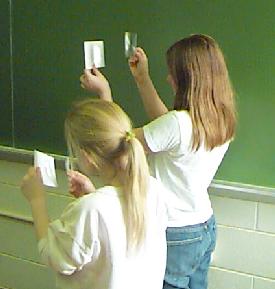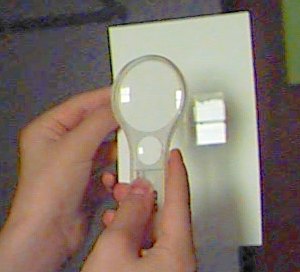
 |
| Laura is holding two lenses at once
Why aren't there two images? |
|---|
Here are some things to think about and do as we start the unit on images. These questions can be answered by simple investigations that will only take a few minutes. Do all of these. You should also discuss what you predict will be observed (if it is a situation with which you are already familiar).
For these activities you should be standing in a fairly dim area, such as inside a hallway looking towards the windows in the front door, or under a shady tree. You want the scene you are looking at to be fairly bright (so look outside - cloudy or sunny conditions are both fine), but you and your lens and card should be in a dim area.

| Cathy and Laura are making images of the view through the window that is behind them |
|
The other activities in this unit assume you have gotten this to work -- that you have seen a well-defined picture of something on your card, and know how you did it and can do it again easily. If you are having trouble with this, don't hesitate to email us or even give us a telephone call ((859) 257-3197 or (859) 257-5131).
 Once you find a focused image, interpret
the pattern: how is it related to the scene/window?
Once you find a focused image, interpret
the pattern: how is it related to the scene/window?
 Predict what will happen to the image on the card
if
you cover part of the lens with your hand.
Will half of the image go away? Or something else happen?
Try
it! Can you tell whether the covering is on the right, on
the left, or a finger across the middle?
Predict what will happen to the image on the card
if
you cover part of the lens with your hand.
Will half of the image go away? Or something else happen?
Try
it! Can you tell whether the covering is on the right, on
the left, or a finger across the middle? Label the positive lenses A,B,C,D.
Make an image of a distant scene (that is, something more than 3 meters away) with each of them.
Measure the distance between lens and card, that gives an image on the card.
This is called the focal length
for the
lens.
Enter this in the table below.
While you are measuring the focal lengths, notice how the
images on the card are alike, and how are they different.
In particular, note which lens gives the largest image, and which gives the smallest, and record this on the table (by writing "largest" or "smallest" on the second row).
Indicate the lens that has the largest focal length by writing "largest" at the
top of the column; similarly note the lens with the shortest focal length.
Label the positive lenses A,B,C,D.
Make an image of a distant scene (that is, something more than 3 meters away) with each of them.
Measure the distance between lens and card, that gives an image on the card.
This is called the focal length
for the
lens.
Enter this in the table below.
While you are measuring the focal lengths, notice how the
images on the card are alike, and how are they different.
In particular, note which lens gives the largest image, and which gives the smallest, and record this on the table (by writing "largest" or "smallest" on the second row).
Indicate the lens that has the largest focal length by writing "largest" at the
top of the column; similarly note the lens with the shortest focal length.
| Lens | ||||
|---|---|---|---|---|
| A | B | C | D | |
| focal length |
||||
| | ||||
| | ||||
| | ||||
*
Use each lens as a magnifier, holding it right at your eye. Which lens
is the strongest magnifier (gives the biggest view), and which is the weakest?
Enter this in the table, too.
 Summarize: How does the focal length of
a lens affect the things it can do?
Summarize: How does the focal length of
a lens affect the things it can do?